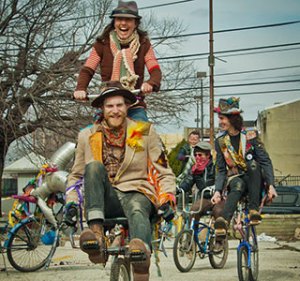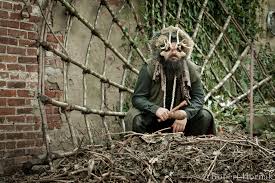The following is Sarah Thompson’s reflection on the Carnival de Resistance, an art intervention and communal lifestyle experiment that set up residencies first in Harrisonburg, Va and Charlottesville, Va in the fall of 2013 then in the Wildgoose Festival in the summer of 2014. Sarah Thompson is the Executive Director of the Christian Peacemaker Teams, an organization that is partnering with nonviolent movements around the world, seeking to embody an inclusive, ecumenical and diverse community of God’s love.
******************************************************************************
As a theologian and scholar-activist, I loved sharing circus theology and inviting the curious and the apathetic, the annoyed and the skeptic, into our whirling-twirling experiment of life together under the shelter of God’s big tent. I reveled for the month in the space; a space that by God’s grace and Earth’s sustenance held all manner of creatures, odd connections, swirling energies, and hard questions. Even though we as individuals did not have the answers to many of the questions that arose from our troupe and the local audience-participants, we COULD gain collective wisdom or flashes of insight by putting them into holy PLAY and embodied conversation through the performance of old stories and the community practices of returning to ancient pathways.
I feel it was a beautiful, wild, experiment in recovering the soul, especially the souls of white folks who participated as part of the CdR family and audience members. Like the souls of people of color, the souls of white people have been covered over and encrusted by violence. On the personal, cultural, and institutional levels violence affects people of color and white people, but in different ways. Recovery of our souls comes from uncovering the various impacts of violence and discovering ways to restore.
To use the term recover conveys that I feel our natural state is health, wholeness. In order to recover their soul and live in healthy ways on this land mass, white folks in the Americas need people of color in order to understand the whole story. They need to be in full conversation our narratives and ideas, our bodies and presence, our life-rhythms and songs. Many times, in an attempt to become whole these things are taken or appropriated without attention to the power dynamics. Though I was not involved in choosing most of the content of the elemental presentations, I learned that the organizers were keenly aware of the violence of cultural appropriation and did not take liberally from traditions of indigenous people in West Africa, the Americas, and African Diaspora, but with permission and care. That is key.
CdR organizers were honest about who they were, the white privilege they often carried, the specific perspective they came from, and the brokenness they felt because of violence in their relationships with land, other peoples, and God. Their vision of recovery resonated with mine, though our individual and community processes are different. That is okay, CdR did not try to be “all things to all people,” and resisting that temptation was one way of countering white supremacy. After prayerfully wrestling through loads of potential material to guide this project, they were clear and at peace about some of the limitations we would face, and the fine lines on which we would dance. Recognizing the boundaries did not mean silencing dissent or disregarding critique. An invitation for all participants to be attentive to their own emotional process throughout the month and to comment on the CdR process allowed space for me as a person of color to share about the impact of white racism and structural violence on my soul in general, and specifically as it showed up in the CdR.
Part of the reason I was invited to participate in the CdR was in order to pay close attention to power dynamics, and to be present as white folks did their soul recovery work. There were a few other people of color too…all of us life-artists and all of us invited to bring our full, dancing, skeptical selves to this experiment. All invited to name when things felt damaging or uncomfortable as a result of personal, cultural, or institutional racism. This ability was considered a skill just like many of the other artistic skills needed to produce a theatrical event in the context of intentional community life. My budding expertise, developed from years of both life experience and academic theorizing, was respected. The organizers did not overloaded with many other daily CdR tasks (as is often happens to chaplains and conflict resolution personnel, etc.) so that as inevitable conflict arose I could have enough energy to be present to it. Just like all the other pieces of the CdR world, knowledge about the subject of transforming violence and oppression was also held collectively. No one person in the CdR crew was expected to have all the good ideas about a subject.
 Along the way of recovery, tumbling toward deep reconciliation, we uncovered areas of brokenness and discovered loving powers we didn’t know we had. CdR was powerful because we didn’t just talk about things and then continue with “business as usual.” We sang, yelled, built, deconstructed, biked, painted, massaged, cried, and acted our way out of “business as usual.” In the hospitable and watching land of the Sinibo (Harrisonburg) an the Monacan (Charlottesville) I got to preach, perform, consult, play, laugh, learn, compost everything, re-wild, sing. This is a month I will never forget for the rest of my life.
Along the way of recovery, tumbling toward deep reconciliation, we uncovered areas of brokenness and discovered loving powers we didn’t know we had. CdR was powerful because we didn’t just talk about things and then continue with “business as usual.” We sang, yelled, built, deconstructed, biked, painted, massaged, cried, and acted our way out of “business as usual.” In the hospitable and watching land of the Sinibo (Harrisonburg) an the Monacan (Charlottesville) I got to preach, perform, consult, play, laugh, learn, compost everything, re-wild, sing. This is a month I will never forget for the rest of my life.


Pingback: 7 Radical Discipleship communities that have shaped my journey as an Anabaptist | Young Anabaptist Radicals